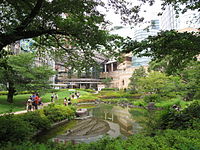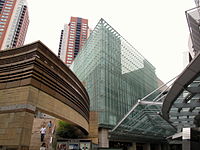
Back روبونغي هيلز Arabic Roppongi Hills Spanish روپونگی هیلز Persian रोप्पोंगी हिल्स Hindi Roppongi Hills Italian 六本木ヒルズ Japanese 롯폰기 힐스 Korean Bukit Roppongi Malay Roppongi Hills Portuguese Roppongi Hills Swedish
| Roppongi Hills | |
|---|---|
 Roppongi Hills, with the Mori Tower (right) and the Residences B and C (left) | |
 | |
| General information | |
| Location | Minato, Tokyo, Japan |
| Coordinates | 35°39′36″N 139°43′48″E / 35.66000°N 139.73000°E |
| Construction started | 2000 |
| Completed | 2003 |
| Opening | April 25, 2003 |
| Owner | Mori Building |
| Height | |
| Roof | Mori Tower: 238.1 m (781 ft)[1] Residences B and C: 159.1 m (522 ft)[1] Grand Hyatt Tokyo: 95.7 m (314 ft)[1] |
| Technical details | |
| Floor count | Mori Tower: 54 Residences B and C: 43 Grand Hyatt Tokyo: 21 |
| Floor area | Total: 724,000 m2 (7,790,000 sq ft)[2] |
| Design and construction | |
| Architect(s) | Kohn Pedersen Fox |




Roppongi Hills (六本木ヒルズ, Roppongi Hiruzu) is a development project in Tokyo and one of Japan's largest integrated property developments, located in the Roppongi district of Minato, Tokyo.
Constructed by building tycoon Minoru Mori, the mega-complex incorporates office space, apartments, shops, restaurants, cafes, movie theatres, a museum, a hotel, a major TV studio, an outdoor amphitheatre, and a few parks. The centrepiece of the complex is the 54-story Roppongi Hills Mori Tower. Mori's stated vision was to build an integrated development where high-rise inner-urban communities allow people to live, work, play, and shop in proximity to eliminate commuting time. The company argued that this would increase leisure time, quality of life, and benefit Japan's national competitiveness. 17 years after the design's initial conception, the complex opened to the public on April 25, 2003. The architecture and use of space is documented in the book Six Strata: Roppongi Hills Redefined.[3]
- ^ a b c "Roppongi Hills". The Skyscraper Center. Council on Tall Buildings and Urban Habitat. Archived from the original on 23 October 2022. Retrieved 8 April 2023.
- ^ "Jerde PlaceMaking". Jerde.com. 2011-10-10. Archived from the original on 2016-06-16. Retrieved 2013-08-11.
- ^ Homma, Takashi (2006). Six Strata: Roppongi Hills Redefined. London: Heibonsha. ISBN 4582277594.